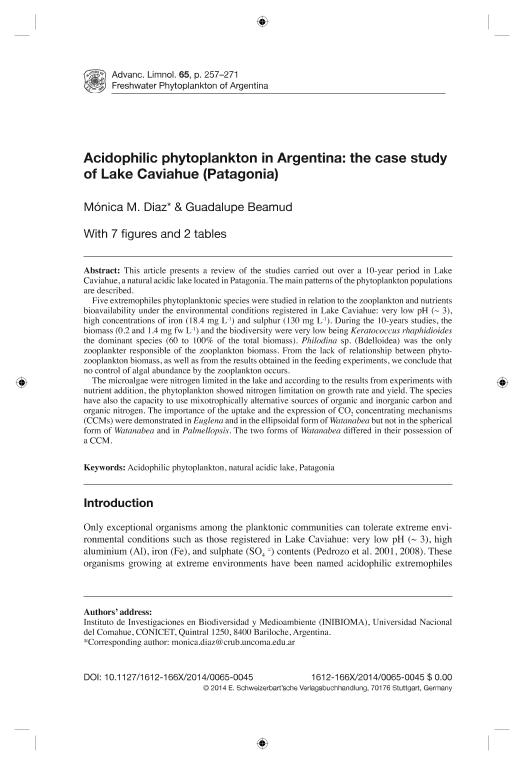Mostrar el registro sencillo del ítem
dc.contributor.author
Diaz, Monica Mabel

dc.contributor.author
Beamud, Sara Guadalupe

dc.date.available
2016-07-26T15:46:41Z
dc.date.issued
2014-07-07
dc.identifier.citation
Beamud, Sara Guadalupe; Diaz, Monica Mabel; Acidophilic phytoplankton in Argentina: the case study of Lake Caviahue (Patagonia); E Schweizerbartsche Verlags; Advances in Limnology; 65; 7-7-2014; 257-271
dc.identifier.issn
1612-166X
dc.identifier.uri
http://hdl.handle.net/11336/6685
dc.description.abstract
This article presents a review of the studies carried out over a 10-year period in Lake Caviahue, a natural acidic lake located in Patagonia. The main patterns of the phytoplankton populations are described. Five extremophiles phytoplanktonic species were studied in relation to the zooplankton and nutrients bioavailability under the environmental conditions registered in Lake Caviahue: very low pH (~3), high concentrations of iron (18.4 mg L-1) and sulphur (130 mg L-1). During the 10-years studies, the biomass (0.2 and 1.4 mg fw L-1) and the biodiversity were very low being Keratococcus rhaphidioides the dominant species (60 to 100% of the total biomass). Philodina sp. (Bdelloidea) was the only zooplankter responsible of the zooplankton biomass. From the lack of relationship between phytozooplankton biomass, as well as from the results obtained in the feeding experiments, we conclude that no control of algal abundance by the zooplankton occurs. The microalgae were nitrogen limited in the lake and according to the results from experiments with nutrient addition, the phytoplankton showed nitrogen limitation on growth rate and yield. The species have also the capacity to use mixotrophically alternative sources of organic and inorganic carbon and organic nitrogen. The importance of the uptake and the expression of CO2 concentrating mechanisms (CCMs) were demonstrated in Euglena and in the ellipsoidal form of Watanabea but not in the spherical form of Watanabea and in Palmellopsis. The two forms of Watanabea differed in their possession of a CCM.
dc.format
application/pdf
dc.language.iso
eng
dc.publisher
E Schweizerbartsche Verlags

dc.rights
info:eu-repo/semantics/openAccess
dc.rights.uri
https://creativecommons.org/licenses/by-nc-sa/2.5/ar/
dc.subject
Acidophilic Phytoplankton
dc.subject
Natural Acidic Lake
dc.subject
Patagonia
dc.subject.classification
Biología Marina, Limnología

dc.subject.classification
Ciencias Biológicas

dc.subject.classification
CIENCIAS NATURALES Y EXACTAS

dc.title
Acidophilic phytoplankton in Argentina: the case study of Lake Caviahue (Patagonia)
dc.type
info:eu-repo/semantics/article
dc.type
info:ar-repo/semantics/artículo
dc.type
info:eu-repo/semantics/publishedVersion
dc.date.updated
2016-07-22T18:53:41Z
dc.journal.volume
65
dc.journal.pagination
257-271
dc.journal.pais
Alemania

dc.journal.ciudad
Stuttgart
dc.description.fil
Fil: Diaz, Monica Mabel. Consejo Nacional de Investigaciones Científicas y Técnicas. Centro Científico Tecnológico Patagonia Norte. Instituto de Investigación en Biodiversidad y Medioambiente; Argentina
dc.description.fil
Fil: Beamud, Sara Guadalupe. Consejo Nacional de Investigaciones Científicas y Técnicas. Centro Científico Tecnológico Patagonia Norte. Instituto de Investigación en Biodiversidad y Medioambiente; Argentina
dc.journal.title
Advances in Limnology
dc.relation.alternativeid
info:eu-repo/semantics/altIdentifier/url/http://www.schweizerbart.de/papers/adv_limnology/detail/65/84042/Acidophilic_phytoplankton_in_Argentina_the_case_st?af=crossref
dc.relation.alternativeid
info:eu-repo/semantics/altIdentifier/doi/http://dx.doi.org/10.1127/1612-166X/2014/0065-0045
dc.relation.alternativeid
info:eu-repo/semantics/altIdentifier/url/https://www.schweizerbart.de/papers/adv_limnology/detail/65/84042/Acidophilic_phytoplankton_in_Argentina_the_case_study_of_Lake_Caviahue_Patagonia
dc.relation.alternativeid
info:eu-repo/semantics/altIdentifier/hdl/10.1127/1612-166X/2014/0065-0045
Archivos asociados
